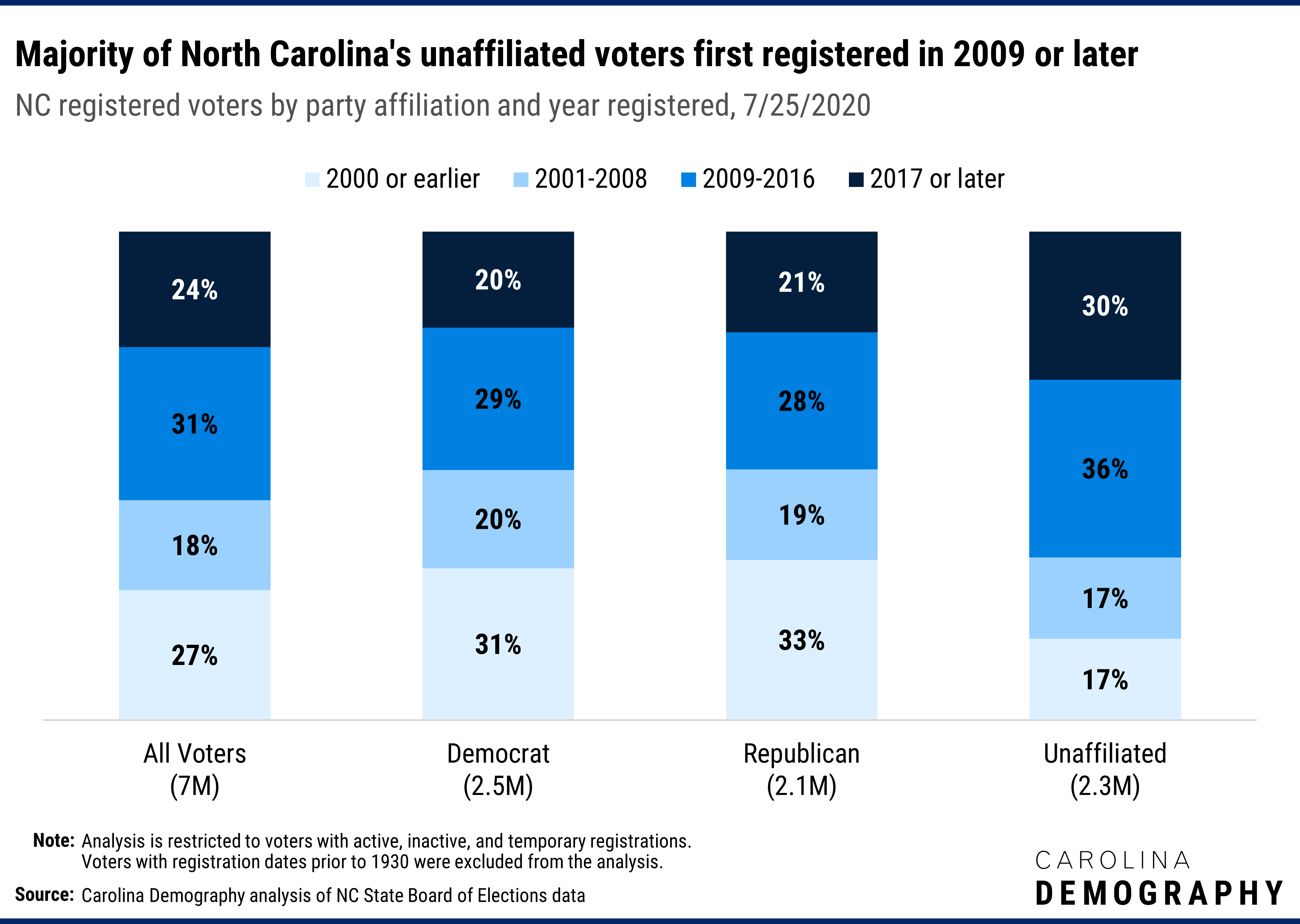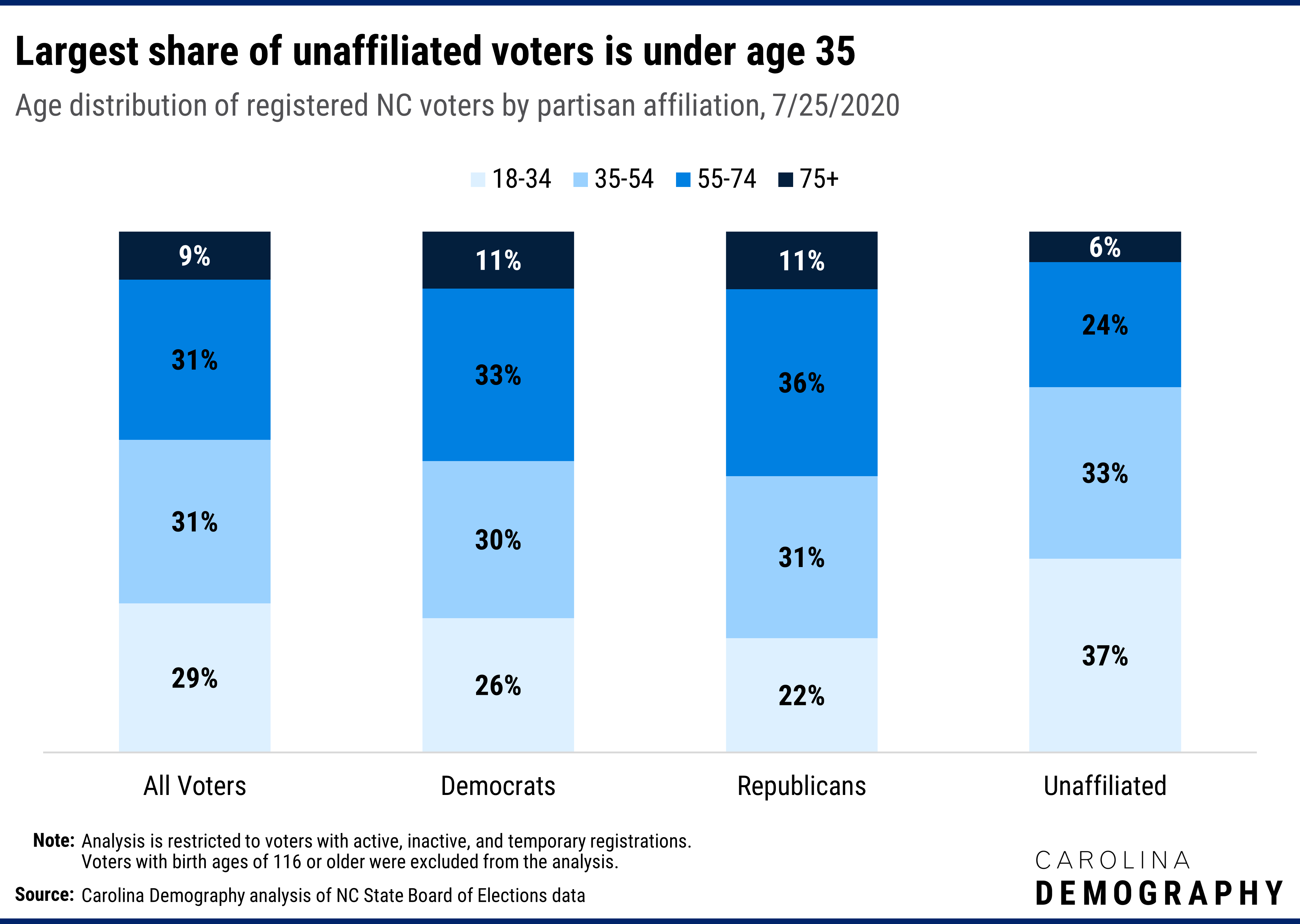What Is The Percentage Of Registered Republicans In Asheboro Nc
This is the first in a three-role series on North Carolina'due south voters. Today, we take a look at North Carolina's 7 million registered voters. In the coming days, we will take a expect at Due north Carolina's registered Republicans and Democrats, respectively.
As of July 25th, 2020, North Carolina had near vii.8 million voting-eligible adults and 7 meg registered voters. Their partisan affiliation was roughly divide between three groups: Democrat, unaffiliated, and Republican, with a slight lead to Democrats. Specifically:
- 2,537,032 or 36% were registered Democrat;
- 2,344,632 or 33% were registered unaffiliated;
- 2,104,881 or 30% were registered Republican; and
- 47,334 or 0.7% were registered to another party.
Other political party registrations included Libertarian (41,170 or 0.6%), Constitution Party (3,646 or 0.05%), and Greenish Party (two,518 or 0.04%).

Who are these voters? And how do demographic characteristics vary among the largest amalgamation groups (Democratic, Republican, and unaffiliated)?
Registration Date
Statewide, just over ane fourth (27%) of voters first registered to vote in 2000 or early. This was roughly one in iii of North Carolina'southward Democrat and Republican voters and less than one in five unaffiliated voters first registered during this time.
Two-thirds of unaffiliated voters offset registered between either 2009-2016 (36%) or in 2017 or afterward (30%); less than half of Democrat and Republican voters registered in 2009 or later. This reflects ii factors: commencement, historic period group differences in partisan affiliation and second, the rise of unaffiliated voters in contempo years.

Age
Young voters are more probable to register as unaffiliated than whatsoever other age group: 43% of eighteen-34 yr-olds are registered unaffiliated versus 35% of 35-44 year-olds, 26% of 55-74 year-olds, and 21% of voters 75 and older.

Conversely, 18-34 year-olds are least probable to register as Republican (23%) and adults ages 55-74 (35%) and 75 and older (36%) are the most likely to register as Republican. Older voters—ages 75 and older—are the nigh likely to register equally Democrats (43%), followed by voters 55-74 (39%).
Reflecting these age patterns in partisan affiliation, the youngest voters brand upward the smallest share of Republican voters (22%) and the largest share of unaffiliated voters (37%). Meanwhile, both Republican and Democrat registered voters have a higher share of voters ages 55-74 and a slightly higher share of 75 and older than the electorate overall.

Race/Ethnicity
There are meaning differences in party registration by race and ethnicity. Black (79%) and American Indian (fifty%) voters are most likely to be registered Democrat while white (23%) voters are least likely to be registered Democrat. In contrast, white voters (41%) are well-nigh likely to exist registered Republican and black (2%) voters are least likely to be registered Republican. Asian (52%) and Hispanic (43%) voters are most likely to be registered unaffiliated, followed past white (35%) and American Indian voters (32%). Black voters (xviii%) are the least likely to be registered unaffiliated.

Equally a result of these differing registration patterns, North Carolina's registered Republicans are overwhelmingly white. Ninety-one percent of Republican voters are white compared to 65% of the electorate overall.
Autonomous voters are the only party where white voters are a minority of registered voters: 43% of registered voters identify as white. Black voters comprise the largest share of registered Democrats (45%).

Unaffiliated voters are more diverse, with college shares of Hispanic (4%) and Asian (2%) voters than the electorate overall. The high shares of "Other" race voters among unaffiliated registrants (13%) largely reflects increases in the share of recently registered voters who practice not report a race or ethnic identification on their voter registration form.
Place of nascency
More than than two in every five (41%) of registered voters in N Carolina was born in the state. Another sixteen% did non study a identify of birth. New York (vi%), other countries (iv%), and Virginia (3%) were the adjacent nigh mutual places of birth.
N Carolina-born voters were more common amidst registered Democrats (45%) and Republicans (44%); unaffiliated voters were less likely to be built-in in North Carolina (35%) than the average registered voter.
Party preferences vary by place of birth with some regional patterns evident. DC and Carolina-built-in voters were nearly likely to annals equally Democrats: 51% of voters born in DC are registered as Democrats, the highest of whatsoever state of birth, followed by South Carolina (42%) and North Carolina (39%) built-in voters.
Midwestern-born voters were most likely to annals equally Republican: xl% of West Virginia-born voters are registered Republican, followed past South Dakota (forty%), Kentucky (39%), Oklahoma (37%), Indiana (37%), and Nebraska (37%).
Northeastern-born voters, meanwhile, were about probable to annals unaffiliated. Nearly half—49%—of Rhode Island, New Hampshire, and Massachusetts-born voters registered as unaffiliated, followed by Vermont (47%).
Geography
Across North Carolina's 100 counties, the partisan affiliation of voters varies widely, reflecting county differences in composition by age, race/ethnicity, and place of nascence. Voters in western counties are more often than not more likely to be registered Republican, for example, while those in northeastern counties are more than probable to be registered Democrat.
Sixty percent of active voters in Mitchell County were registered Republican, the highest rate statewide. Mitchell also had the lowest charge per unit of registered Democratic voters. In Hertford Canton, meanwhile, 69% of voters are registered Democrat, the highest rate statewide; Hertford also had the lowest rate of registered Republican voters
There are less clear regional patterns in unaffiliated registrations. The top ten counties for unaffiliated voters include:
- Western counties of Transylvania (43%), Watauga (43%), Henderson (42%), and Buncombe (39%);
- Coastal counties of Camden (43%), Currituck (42%), Dare (40%), and Onslow (39%); and
- The Triangle counties of Orange (39%) and Wake (38%).
Note: assay presented is of the 7/25/2020 voter registration file from NC's State Lath of Elections. Analysis is limited to individuals who are active, inactive, or temporary registered voters. Voters with reported birth age of 116 years or older were excluded from the historic period analysis. Voters with registration dates prior to 1930 were excluded from the registration date analysis.
Republish our content for complimentary under a Creative Commons license.
Demand help agreement population change and its impacts on your community or business? Carolina Demography offers demographic research tailored to your needs.
Contact united states of america today at demography@unc.edu for a gratis initial consultation.
Contact U.s.a.
Categories: Elections & Voting, NC in Focus
What Is The Percentage Of Registered Republicans In Asheboro Nc,
Source: https://www.ncdemography.org/2020/08/13/who-are-north-carolinas-7-million-registered-voters/
Posted by: townsendhowles1955.blogspot.com


0 Response to "What Is The Percentage Of Registered Republicans In Asheboro Nc"
Post a Comment